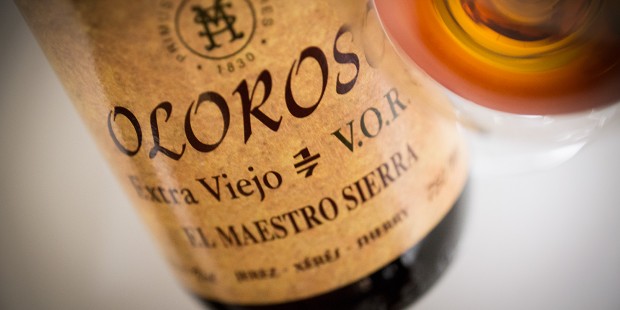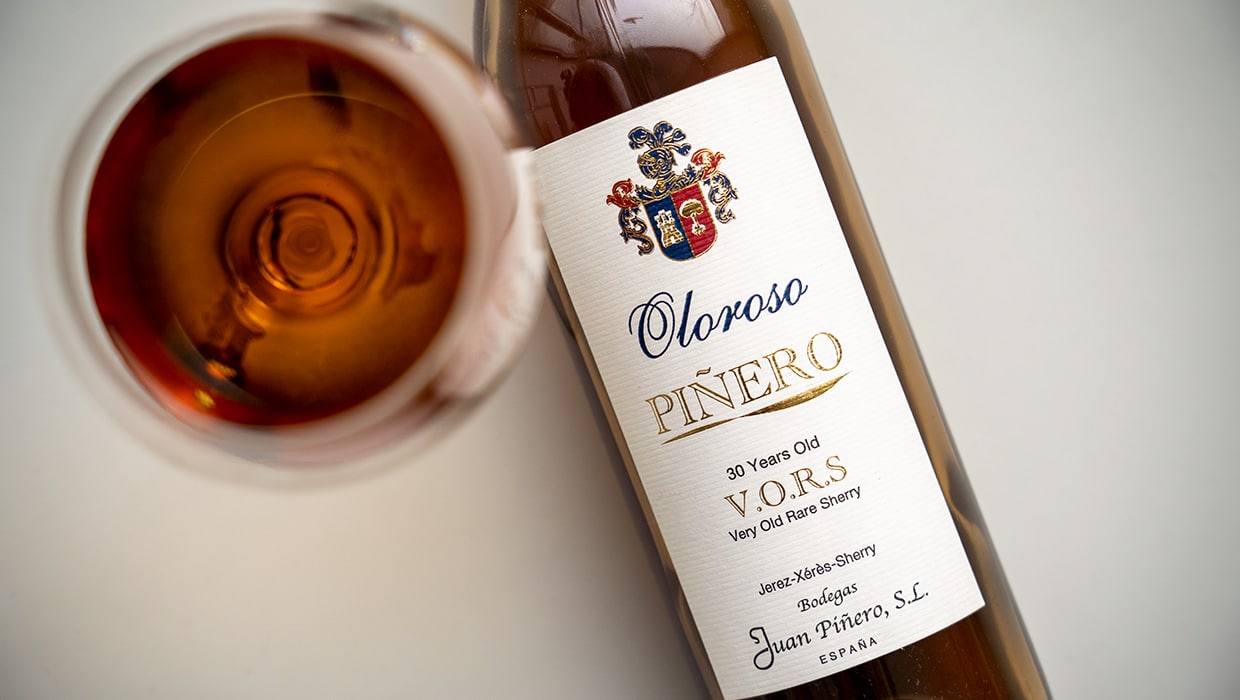
Oloroso
Oloroso is aged in the absence of flor, in an oxidative way. This style of sherry starts from a selection of heavier, more full-structured musts than a Fino. Usually it is produced from a second pressing of Palomino grapes. After fermentation, the young wines with a thicker body will be destined for maturation as Oloroso sherry.
To create an Oloroso the base wine will be fortified to 17 or 18 degrees which makes it impossible for flor yeasts to survive in these casks. Due to evaporation known as merma (+/- 3-5% each year), the resulting Oloroso will grow more concentrated to around 20-22 degrees.
Oloroso means fragrant and the best examples will display dried fruits, leather, polished wood and exotic spices
After fermentation the base wines will be classified with chalk signs on the cask, according to their finesse. Delicate wines suited for biological ageing were given a raya, a stick or vertical line. Later some leaves were added to form a palma. The heavier wines, more suited for oxidative ageing, are given a circular mark ‘o’ for Oloroso. Even courser, slightly unbalanced base wines would be given two or more rayas. These will age as olorosos of lesser quality, sometimes used for blending purposes, distillation or the production of sherry vinegar.
Oloroso sherry casks are highly sought after by the whisky industry. It adds a lot of richness when spirits are matured in casks that were seasoned with Oloroso.
For more information on Oloroso sherry, check the page on the website of the Consejo Regulador of the sherry region.

Old Oloroso from Bodegas Juan Piñero
Dry and sweet Oloroso character
Oloroso sherry often shows nutty aromas (especially walnuts), combined with polished / balsamic notes, dried fruits, toasted hints, tobacco and other autumnal aromas. There are noticeable spicy notes in older examples. Often there are also subtle meaty hints, truffle and leather.
The technical file states that Oloroso is made from Palomino grapes as a dry wine. In the past many Oloroso sherries were lightly sweetened by adding a bit of Pedro Ximénez (called Amoroso or Abocado sherry, or Rich Oloroso). Some of the oldest olorosos on the market have historically been lightly sweetened but tend to lose this sweetness as they mature further. Nowadays the rules of the Denomination of Origin state that a wine needs to be fully dry to have Oloroso on the label. Anything else will be labeled Medium or Cream sherry (depending on the sugar content). If there is at least 85% of dry Oloroso in the mix, the term Medium Blend of Oloroso can also be used.
Note that the higher strength and full body of an Oloroso (caused by glycerol) will give it an impression of roundness. The glyceric side can even be mistaken for a subtle sweetness, even in a technically dry wine. To complicate things further, there is also a type of naturally sweet Oloroso (usually vintage sherry), produced by cutting off the fermentation process early (leaving more residual sugars). These belong to the Dulce category.
Appreciation and pairing
The classic pairing for an Oloroso would be red meat and game, but it will also be lovely with well-aged cheese. Read more about pairing Oloroso with food. It is served around 12-16°C.
Oloroso sherry reviews
- Almacenista Oloroso ‘Pata de Gallina’ (Lustau)4.5
- Castillo de Guzmán Oloroso (Cooperativa Albarizas)3
- Collection Oloroso 12 years (Williams & Humbert)2.5
- Colosía Oloroso Seco (Gutiérrez Colosía)3.5
- Cuco Oloroso 12 Years (Barbadillo)4.5
- Don Fernando Oloroso (Marks & Spencer)4
- Don Gonzalo Oloroso VOS (Valdespino)4
- Gobernador Oloroso (Emilio Hidalgo)4
- Harveys Rich Old Oloroso V.O.R.S.4.5
- La Bota de Oloroso 28 (Equipo Navazos)4.5
- La Bota de Oloroso 63 (Equipo Navazos)4.5
- La Bota de Oloroso 98 ‘Bota NO’ (Equipo Navazos)4.5
- Los Abandonados 6|8 (Alexander Jules)4.5
- Lustau Añadas: vertical tasting 1989-20024.5
- Matusalem Oloroso Dulce VORS (Gonzalez Byass)4
- Old & Plus Oloroso VORS (Romate)4.5
- Old sherry miniatures (part 2)
- Oloroso ‘Viuda de Antonio Borrego’ (Lustau)
- Oloroso 15 años (El Maestro Sierra)3.5
- Oloroso 1750 (Fernández-Gao)4
- Oloroso 2001 Colección Añadas (Williams & Humbert)4.5
- Oloroso 2001 Historic Vintage (Williams & Humbert)4
- Oloroso 40 years (Xpertvinum)4.5
- Oloroso 70 years (Xpertvinum)4.5
- Oloroso Almirante (Marqués del Real Tesoro)3.5
- Oloroso Añada 1964 (Gonzalez Byass)5
- Oloroso Añada 1975 (Bodegas Tradición)4.5
- Oloroso Añada 1990 (Lustau)4
- Oloroso Añada 1997 (Lustau)4
- Oloroso Antique (Fernando de Castilla)4
- Oloroso Aurora (Yuste)3
- Oloroso Baco Imperial VORS (Dios Baco)4.5
- Oloroso El Cerro (Callejuela)4.5
- Oloroso Emperatriz Eugenia (Lustau)4
- Oloroso En Rama (Carvajal)3.5
- Oloroso En Rama 2003 / Oloroso En Rama 2009 (Williams & Humbert)3.5
- Oloroso En Rama 2012 (Williams & Humbert)3.5
- Oloroso Encontrado 1|5 (Sánchez Romate)4.5
- Oloroso Extra Viejo 1|7 VORS (El Maestro Sierra)5
- Oloroso Ochavico (Garvey)3
- Oloroso Ostión (The Wine Bang)4.5
- Oloroso Solera India (Osborne)4.5
- Oloroso V.O.R.S. (Tradicion)4.5
- Oloroso Viejísimo (M. Ant. De La Riva)5
- Oloroso VORS (Juan Piñero)4.5
- Poley Oloroso En Rama 15 Años (Toro Albalá)3
- Port of Leith Oloroso Sherry3
- Río Viejo Oloroso (Lustau vs. late 1970s Domecq)3.5
- Sangre y Trabajadero (Gutiérrez Colosía)4
- Sibarita Oloroso VORS (Osborne)4.5
- Solera 1842 VOS (Valdespino)4
- Tierra de Oro Oloroso (El Corte Inglés)1.5
- Very Rare Oloroso 1|60 (Marks & Spencer)4
- Villapanés Oloroso Seco (Hidalgo)4
- Xixarito Oloroso (Bodegas Barón)3
- ZEREJ II – Oloroso (Barbadillo)4






